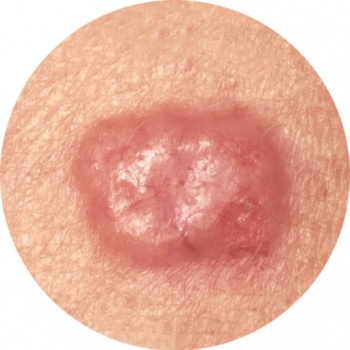The most common types of skin cancer are melanoma, basal cell cancer, and squamous cell carcinoma. These conditions develop on the outer and middle layers of the epidermis. While melanoma is the deadliest form of skin tumor, basal cell cancers are less dangerous and are often curable with surgery or radiation. Squamous cell skin cancers are more common than melanoma and are typically not life-threatening, but are still serious and should be treated appropriately.
Squamous cell carcinoma is the most common type of skin cancer and is largely found on areas of the body exposed to the sun. However, it can also develop on areas not exposed to the sun. It has the tendency to invade the fatty tissue under the surface of the skin and spread. It is very difficult to cure, so early detection is essential. Some types of squamous cell carcinoma spread rapidly and are difficult to treat.
Squamous cell carcinoma is another type of skin cancer. It develops in the cells that line the inner layer of the skin. Squamous cells are a type of cell that resembles eczema, but is malignant. The disease is often not asymptomatic, and symptoms include a red, flat, or scaly bump. A biopsy is necessary to diagnose and treat this form of skin cancer.
Non-melanoma skin cancers are the least common form of skin cancer. They begin in the keratinocytes of the epidermis. SCCs typically appear on areas of the body that have been exposed to the sun for long periods of time. They can also appear in scars or on areas of the body that have been ulcerated or burned. Fortunately, SCCs rarely spread to the lymph nodes or other parts of the body.
The most common type of skin cancer is basal cell carcinoma. Its rate of spread is slow, with only about two percent of cases spreading to other organs. Generally speaking, most cases of SCC occur on the face and chest. Some may look like eczema or other skin lesions, while others may mimic other types of cancer. Squamous cell carcinoma can also occur in other parts of the body.

Melanoma is the most common type of skin cancer and has a low rate of metastasis. It develops on the epidermis in areas of the body that have been exposed to the sun for a long time. It often appears as a red bump or scaly patch. It may also look like a wart. It is not common, but is a symptom of skin cancer.
Melanoma is the most common type of skin cancer. This happens when pigment cells in the epidermis, known as melanocytes, grow out of control. The health website IGS MX explains that unlike other skin cancers, melanomas tend to spread rapidly if left untreated. Although melanomas make up only one percent of all skin cancers, they are the most serious type of all.
Among the most common types of skin cancer, basal cell carcinoma is the least serious. It can be treated only with surgery, but if you have it in an early stage, it can spread throughout the body and become fatal. If it is caught early, it is curable in most cases, but it can spread to other parts of the body and become difficult to treat. The most common types of skin cancer are squamous cell carcinoma, atypical fibroxanthoma, and angiosarcoma.
Basal cell carcinoma is the second most common type of skin cancer. It accounts for about 20 percent of all non-melanoma skin cancers. Basal cell carcinomas develop from the flat squamous cells of the epidermis, the outer layer of the skin. The most common type of basal cell carcinoma is melana. It can be painful, and can cause disfiguring effects. It may be difficult to diagnose at the early stage, but it is important to seek medical attention.
The most common type of skin cancer is basal cell carcinoma. It is the most deadly, causing nearly half of all skin cancer-related deaths each year. It usually forms in the melanocyte cells of the skin, which produce pigment. Both types of skin cancers can cause unusual changes in the skin, including a white rash or an irregular-colored spot. A dermatologist can determine which type of skin cancer is the most dangerous, but there are some other warning signs.